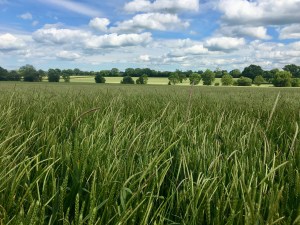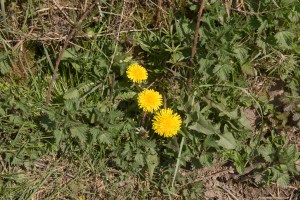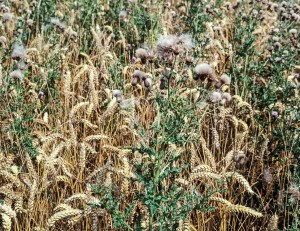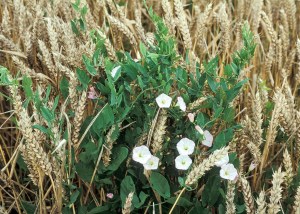Written by CPM Magazine from CPM Magazine
Download PDF
Is it time we had a major rethink about how we approach weeds? Renowned agroecologist and soil expert Nicole Masters certainly believes so. CPM gets some insight on why that is and how the information can be utilised by growers.
By Emily Padfield
Weeds – they’re every grower’s nemesis. Whether arable, livestock or just plain old garden enthusiast, millions of pounds and man hours go towards attempting to eradicate them. Yet it’s a futile war to wage and is getting even more so as chemical efficacy starts to waver and soils begin to falter.
So what is a weed? Its Oxford Dictionary definition is: “Any plant that grows in an unwanted place, especially in a garden or field where it prevents cultivated plants from growing freely.”

Nicole Masters believes there’s a lot to learn from seemingly nuisance plants – weeds.
Weed is an easy word to use. Any plant can be a weed in any setting. But what are they trying to tell us and what are the conditions that set the signal for them to germinate? Globally-renowned agroecologist and systems thinker Nicole Masters believes there’s a lot to learn from these seemingly nuisance plants.
She believes a paradigm shift is needed when looking at weed control, believes Nicole, speaking at a two-day course organised by Bridget Elworthy and Henrietta Courtauld of Land Gardeners at Althorp Estate last Autumn.
Nicole is a regenerative soil educator, author of the best-selling “For the love of Soil” and consultant for more than 26 million hectares across the world. “Weeds should be classified as doctors of the soil,” she explains. “We can reframe how we look at what we see growing and see it more as an enquiry: Why is that growing here?
“As with drugs and cancer, we will never win the war on weeds by being reactive in our thinking. However, we can identify the root cause and change the signal that allows these weeds to germinate,” she suggests.
“We have to move away from the attack, dominate and kill approach to cropping. Let’s work with Mother Nature in order to respond rather than react. It seems that for many cropping conventionally, every day it’s a battle of what to kill. We should be heading towards ‘No Kill’ farming wherever possible.”
There are several different signals and reasons why and how ‘weed’ species might germinate. Plants fall into different trigger groups, she adds, which include those that colonise bare ground, grow in response to low organic matter, to open up compacted soils, in response to mineral availability, balance and toxicity, and microbial stimulation.
Bare soil
Many will be aware of fungal to bacteria relationships within soil and what affect these can have on plant health, weed prevalence and disease pressures.
When the soil is bare or disturbed, bacterial levels become high. The first species to arrive can grow even without a functional soil. These include lichen, moss and cryptogams, explains Nicole. “Then come the early colonisers with shallow rooting systems and scrambling growth patterns. These early plants prefer, and even support, bacterially dominated soil conditions.”

Blackgrass is a typical sign of a bacteria dominated soil. Microbial testing under these early colonising species shows high archaea and bacterial dominance which reduce microbial communities and compromise the nitrogen cycle, making the soil inhospitable for other species and crops to grow successfully.
Blackgrass is a typical sign of a bacteria dominated soil, she adds. “These annual species produce huge volumes of seeds, adding to their dominance, and can even hold back the natural succession process. Microbial testing under these species shows high archaea and bacterial dominance which, in turn, reduce microbial communities and compromise the nitrogen cycle, making the soil inhospitable for other species and, in particular, crops to grow successfully.
“It’s worth doing tissue tests to find out what the plant is high and low in, to try and tell what the mineral imbalance could be,” she adds.
Dynamic accumulators like these mineral imbalances, explains Nicole. “Take dandelions, for example. They’re known for gathering sodium, silica, magnesium, calcium, potassium, phosphorus, iron and copper and bringing it all to the surface.
“Use a refractometer to determine what plant is flourishing in this environment. If you have a flush of thistles, measure your intended crop compared with the thistle and whichever Brix is higher, the soil conditions are suiting this plant better. If the thistle is a lower Brix than the crop, it could be on its way out. The other way around, and the thistle could be settling in to stay so more aggressive remedial work could be required.”
Farmers aren’t dealing with a pristine resource, there’s a lot of historic loading and often mineral and microbial balances can be out of whack, she goes on to add.
“The weed seedbank in our soils is massive. One single fat hen plant can produce over 600,000 seeds in a season, most of which will remain viable for over 40 years.”
Weeds are able to pump nitrogen back to the soil surface after it has dropped to the lower soil zones, beyond the reach of most crops, and are able to hold the element in reserve. Heavy growth of summer annuals is especially valuable as nitrogen retainers, she explains.

Weed species common on bare soil are also prevalent on low organic matter soils and often have deep penetrating roots. They increase resource availability in low organic matter soils by priming the soil to release bound nutrients and act to kick-start the carbon and soil-building process.
“We’ve all been guilty of looking over the fence and chastising our neighbour for letting their weeds go to seed for fear of them blowing onto our side of the hedge,” she adds. “But really, we’re providing the environment they need to germinate, so it’s within our control.
“Nature can do it all but, as producers, most of the time we can’t wait for nature’s timeline, so there are steps you can take,” she explains.
“Look at the species specifically. A species like knapweed, which feeds archael and monosaccharides, allows a foothold for disease and pests. They keep the conditions ideal for themselves and cause the succession process to stall. We need to interrupt this in some way, whether it be heavy animal impact, bale grazing or another method.
“As a last resort, cultivation can be used but you must mitigate the harm done by applying humic acids as well as adding organic matter and getting seeds straight into the ground.”
Low organic matter species
Weed species common on bare soil are also prevalent on low organic matter soils, explains Nicole. “Species that prevail in low organic matter soil often have deep penetrating roots. Think of those species that grow in the cracks of concrete or on gravel on the sides of roads, like dandelions, fleabane, knapweed and leafy spurge.”
They use several methods to increase resource availability in low organic matter soils by priming the soil to release bound nutrients and act to kick-start the carbon and soil-building process, she adds.
“When they die, they contribute to organic matter. But the plant process alone of rebuilding organic matter in soils isn’t quick, it takes many decades to substantially lift soil carbon levels.”
Ways of building soil organic matter are to spread, feed and add organic materials like straw, woodchip, composts, hay in the method of bale grazing and things like biochar. “Manage for maximum groundcover using animal trampling, herbal leys, cover crops and consciously try to increase your plant Brix levels,” she advises.
Compacted soil indicators
Obviously, there are numerous causes of soil compaction. It could be due to mineral and microbial imbalances, but equally overgrazing, tillage and the use of soluble nitrogen are all causal factors, says Nicole.

Deep-rooted species like dock and thistle are actually providing a service by opening up tight, compacted soils.
“Many weeds provide growers with an indication that soils are compacted or crusted, which prevents soils from breathing. This lack of oxygen sends a germination signal for things like dock, buttercup, thistles and rushes, to name but a few. They’ve adapted to live in anaerobic soils by pumping oxygen down through their roots to free up nutrients.”
Many of these weeds also suggest that calcium is not functional in the soil. Deep-rooted species like dock and thistle are actually providing a service by opening up tight, compacted soils. Actions for compacted soils include planting a multi-species cover crop, focussing on deep rooting varieties like tillage radish, brassicas, phacelia and cereals like rye and oats can all play a part.
“You need to establish why these soils have become compacted. Is it mineral imbalance, microbes, organic matter, management, mindset, or a mixture of reasons?” she advises.
Mineral availability
High available potassium and low phosphorus levels often provide the trigger for broadleaf weeds, such as dandelions, plantain and night shade. Species like field bindweed suggest low availability of calcium but high levels of magnesium, says Nicole.

Species like field bindweed suggest low availability of calcium but high levels of magnesium.
“Primitive weedy grasses indicate low functional calcium, high nitrates and bacterially dominated soils. So many weed species indicate a breakdown in fungal life, which is often the case in land that has been tilled for long periods of time,” she explains.
“Some weeds flourish in soils which have nutrients in excess and have adapted to grow in environments with otherwise toxic levels of sodium, cadmium, lead, potassium and zinc. Think of those areas where historically things could have caused this, for example, areas for working with livestock, maybe old dumping grounds from the past, or where ground has been reclaimed.”
These ‘release valve’ species include knapweed, barley grass, teasle and ragwort. “Avoid grazing these areas and soil test for potential contamination. Plant other release valve crops, such as sunflowers and willow, and think about treating with biochar and humates to reset the balance.”
Nicole says to expect to see species like cocksfoot, dandelion and nettles in areas around the farmyard or where there’s an excess of nutrients like magnesium, potassium and nitrates.
“We’re never going to run out of minerals, it’s all in the soil but we just need to make it bioavailable. It’s a great way of selling products though,” she jokes.
Microbial stimulation
Generally, plants that want to grow in fungal dominated soils or vice versa won’t flourish if the microbiology is out of kilter. Trees planted into grass without inoculant or other remediation will not grow as well as those in a woodland setting, where soils have higher fungal dominance, explains Nicole.
In a healthy grassland ecosystem, high-value grass species – like tall prairie grass, rye, wheat and corn – prefer soils with biomass of between 1:1 or 1:2 bacteria to fungi ratio. Rarely are things that simple however, Nicole comments. “There’s a large element of random chance involved as to what germinates and what doesn’t.
“As soils become less and less disturbed, fungal biomass lifts and woody weeds like blackberry, roses and sagebrush start to establish. Then, over time, trees start to dominate.
“Early succession plants prefer bacterial-dominated environment and produce this huge volume of seeds which prolong their dominance and prevent the next stage in the process.”
These species tend to be less palatable, coarser and contain less feed value than the more advanced grass species, making them in turn less desirable in a cropping scenario, she describes.
“Above all, get out on your farm and observe what each plant or situation is trying to tell you. All research is anecdotal and area or situation specific. Each field on your farm is different and so will need a different approach. Get a shovel, look at the root systems – where and what grows. Then monitor how different methods of management affect the outcomes.
“Don’t get dogmatic. There’s no reason why 20 years down the track you might not decide to try something different.”
Know your cryptogams
Cryptogams include lichen, cynolichen, algae, mosses and cynobacteria and are described by Nicole as being vital colonisers in environments that have little, no or even dysfunctional topsoil.
“These organisms use powerful acids to draw minerals from their environments and can be found in all environments from desert to tundra. Although they sit at the base of the trophic pyramid, they help to create a crust which in turn captures dust and protects against losses of soil, carbon, water and from UV rays,” explains Nicole.
Cryptogams are excellent sinks for global carbon, with estimates of between 2.1 to 7.4 billion tonnes being held by them each year.
“In nutrient devoid environments, they can also be significant sources of nitrogen, with one study suggesting they can contribute as much as 100kg/ha in some environments.”
Recommended reading
This article was taken from the latest issue of CPM. For more articles like this, subscribe here.
Sign up for Crop Production Magazine’s FREE e-newsletter here.
The post Doctors of the soil appeared first on cpm magazine.
Continue reading on CPM website...
If you are enjoying what you read then why not considering subscribing here: http://www.cpm-magazine.co.uk/subscribe/
Download PDF
Is it time we had a major rethink about how we approach weeds? Renowned agroecologist and soil expert Nicole Masters certainly believes so. CPM gets some insight on why that is and how the information can be utilised by growers.
“We can reframe how we look at what we see growing and see it more as an enquiry: Why is that growing here?”
By Emily Padfield
Weeds – they’re every grower’s nemesis. Whether arable, livestock or just plain old garden enthusiast, millions of pounds and man hours go towards attempting to eradicate them. Yet it’s a futile war to wage and is getting even more so as chemical efficacy starts to waver and soils begin to falter.
So what is a weed? Its Oxford Dictionary definition is: “Any plant that grows in an unwanted place, especially in a garden or field where it prevents cultivated plants from growing freely.”

Nicole Masters believes there’s a lot to learn from seemingly nuisance plants – weeds.
Weed is an easy word to use. Any plant can be a weed in any setting. But what are they trying to tell us and what are the conditions that set the signal for them to germinate? Globally-renowned agroecologist and systems thinker Nicole Masters believes there’s a lot to learn from these seemingly nuisance plants.
She believes a paradigm shift is needed when looking at weed control, believes Nicole, speaking at a two-day course organised by Bridget Elworthy and Henrietta Courtauld of Land Gardeners at Althorp Estate last Autumn.
Nicole is a regenerative soil educator, author of the best-selling “For the love of Soil” and consultant for more than 26 million hectares across the world. “Weeds should be classified as doctors of the soil,” she explains. “We can reframe how we look at what we see growing and see it more as an enquiry: Why is that growing here?
“As with drugs and cancer, we will never win the war on weeds by being reactive in our thinking. However, we can identify the root cause and change the signal that allows these weeds to germinate,” she suggests.
“We have to move away from the attack, dominate and kill approach to cropping. Let’s work with Mother Nature in order to respond rather than react. It seems that for many cropping conventionally, every day it’s a battle of what to kill. We should be heading towards ‘No Kill’ farming wherever possible.”
There are several different signals and reasons why and how ‘weed’ species might germinate. Plants fall into different trigger groups, she adds, which include those that colonise bare ground, grow in response to low organic matter, to open up compacted soils, in response to mineral availability, balance and toxicity, and microbial stimulation.
Bare soil
Many will be aware of fungal to bacteria relationships within soil and what affect these can have on plant health, weed prevalence and disease pressures.
When the soil is bare or disturbed, bacterial levels become high. The first species to arrive can grow even without a functional soil. These include lichen, moss and cryptogams, explains Nicole. “Then come the early colonisers with shallow rooting systems and scrambling growth patterns. These early plants prefer, and even support, bacterially dominated soil conditions.”

Blackgrass is a typical sign of a bacteria dominated soil. Microbial testing under these early colonising species shows high archaea and bacterial dominance which reduce microbial communities and compromise the nitrogen cycle, making the soil inhospitable for other species and crops to grow successfully.
Blackgrass is a typical sign of a bacteria dominated soil, she adds. “These annual species produce huge volumes of seeds, adding to their dominance, and can even hold back the natural succession process. Microbial testing under these species shows high archaea and bacterial dominance which, in turn, reduce microbial communities and compromise the nitrogen cycle, making the soil inhospitable for other species and, in particular, crops to grow successfully.
“It’s worth doing tissue tests to find out what the plant is high and low in, to try and tell what the mineral imbalance could be,” she adds.
Dynamic accumulators like these mineral imbalances, explains Nicole. “Take dandelions, for example. They’re known for gathering sodium, silica, magnesium, calcium, potassium, phosphorus, iron and copper and bringing it all to the surface.
“Use a refractometer to determine what plant is flourishing in this environment. If you have a flush of thistles, measure your intended crop compared with the thistle and whichever Brix is higher, the soil conditions are suiting this plant better. If the thistle is a lower Brix than the crop, it could be on its way out. The other way around, and the thistle could be settling in to stay so more aggressive remedial work could be required.”
Farmers aren’t dealing with a pristine resource, there’s a lot of historic loading and often mineral and microbial balances can be out of whack, she goes on to add.
“The weed seedbank in our soils is massive. One single fat hen plant can produce over 600,000 seeds in a season, most of which will remain viable for over 40 years.”
Weeds are able to pump nitrogen back to the soil surface after it has dropped to the lower soil zones, beyond the reach of most crops, and are able to hold the element in reserve. Heavy growth of summer annuals is especially valuable as nitrogen retainers, she explains.

Weed species common on bare soil are also prevalent on low organic matter soils and often have deep penetrating roots. They increase resource availability in low organic matter soils by priming the soil to release bound nutrients and act to kick-start the carbon and soil-building process.
“We’ve all been guilty of looking over the fence and chastising our neighbour for letting their weeds go to seed for fear of them blowing onto our side of the hedge,” she adds. “But really, we’re providing the environment they need to germinate, so it’s within our control.
“Nature can do it all but, as producers, most of the time we can’t wait for nature’s timeline, so there are steps you can take,” she explains.
“Look at the species specifically. A species like knapweed, which feeds archael and monosaccharides, allows a foothold for disease and pests. They keep the conditions ideal for themselves and cause the succession process to stall. We need to interrupt this in some way, whether it be heavy animal impact, bale grazing or another method.
“As a last resort, cultivation can be used but you must mitigate the harm done by applying humic acids as well as adding organic matter and getting seeds straight into the ground.”
Low organic matter species
Weed species common on bare soil are also prevalent on low organic matter soils, explains Nicole. “Species that prevail in low organic matter soil often have deep penetrating roots. Think of those species that grow in the cracks of concrete or on gravel on the sides of roads, like dandelions, fleabane, knapweed and leafy spurge.”
They use several methods to increase resource availability in low organic matter soils by priming the soil to release bound nutrients and act to kick-start the carbon and soil-building process, she adds.
“When they die, they contribute to organic matter. But the plant process alone of rebuilding organic matter in soils isn’t quick, it takes many decades to substantially lift soil carbon levels.”
Ways of building soil organic matter are to spread, feed and add organic materials like straw, woodchip, composts, hay in the method of bale grazing and things like biochar. “Manage for maximum groundcover using animal trampling, herbal leys, cover crops and consciously try to increase your plant Brix levels,” she advises.
Compacted soil indicators
Obviously, there are numerous causes of soil compaction. It could be due to mineral and microbial imbalances, but equally overgrazing, tillage and the use of soluble nitrogen are all causal factors, says Nicole.

Deep-rooted species like dock and thistle are actually providing a service by opening up tight, compacted soils.
“Many weeds provide growers with an indication that soils are compacted or crusted, which prevents soils from breathing. This lack of oxygen sends a germination signal for things like dock, buttercup, thistles and rushes, to name but a few. They’ve adapted to live in anaerobic soils by pumping oxygen down through their roots to free up nutrients.”
Many of these weeds also suggest that calcium is not functional in the soil. Deep-rooted species like dock and thistle are actually providing a service by opening up tight, compacted soils. Actions for compacted soils include planting a multi-species cover crop, focussing on deep rooting varieties like tillage radish, brassicas, phacelia and cereals like rye and oats can all play a part.
“You need to establish why these soils have become compacted. Is it mineral imbalance, microbes, organic matter, management, mindset, or a mixture of reasons?” she advises.
Mineral availability
High available potassium and low phosphorus levels often provide the trigger for broadleaf weeds, such as dandelions, plantain and night shade. Species like field bindweed suggest low availability of calcium but high levels of magnesium, says Nicole.

Species like field bindweed suggest low availability of calcium but high levels of magnesium.
“Primitive weedy grasses indicate low functional calcium, high nitrates and bacterially dominated soils. So many weed species indicate a breakdown in fungal life, which is often the case in land that has been tilled for long periods of time,” she explains.
“Some weeds flourish in soils which have nutrients in excess and have adapted to grow in environments with otherwise toxic levels of sodium, cadmium, lead, potassium and zinc. Think of those areas where historically things could have caused this, for example, areas for working with livestock, maybe old dumping grounds from the past, or where ground has been reclaimed.”
These ‘release valve’ species include knapweed, barley grass, teasle and ragwort. “Avoid grazing these areas and soil test for potential contamination. Plant other release valve crops, such as sunflowers and willow, and think about treating with biochar and humates to reset the balance.”
Nicole says to expect to see species like cocksfoot, dandelion and nettles in areas around the farmyard or where there’s an excess of nutrients like magnesium, potassium and nitrates.
“We’re never going to run out of minerals, it’s all in the soil but we just need to make it bioavailable. It’s a great way of selling products though,” she jokes.
Microbial stimulation
Generally, plants that want to grow in fungal dominated soils or vice versa won’t flourish if the microbiology is out of kilter. Trees planted into grass without inoculant or other remediation will not grow as well as those in a woodland setting, where soils have higher fungal dominance, explains Nicole.
In a healthy grassland ecosystem, high-value grass species – like tall prairie grass, rye, wheat and corn – prefer soils with biomass of between 1:1 or 1:2 bacteria to fungi ratio. Rarely are things that simple however, Nicole comments. “There’s a large element of random chance involved as to what germinates and what doesn’t.
“As soils become less and less disturbed, fungal biomass lifts and woody weeds like blackberry, roses and sagebrush start to establish. Then, over time, trees start to dominate.
“Early succession plants prefer bacterial-dominated environment and produce this huge volume of seeds which prolong their dominance and prevent the next stage in the process.”
These species tend to be less palatable, coarser and contain less feed value than the more advanced grass species, making them in turn less desirable in a cropping scenario, she describes.
“Above all, get out on your farm and observe what each plant or situation is trying to tell you. All research is anecdotal and area or situation specific. Each field on your farm is different and so will need a different approach. Get a shovel, look at the root systems – where and what grows. Then monitor how different methods of management affect the outcomes.
“Don’t get dogmatic. There’s no reason why 20 years down the track you might not decide to try something different.”
Know your cryptogams
Cryptogams include lichen, cynolichen, algae, mosses and cynobacteria and are described by Nicole as being vital colonisers in environments that have little, no or even dysfunctional topsoil.
“These organisms use powerful acids to draw minerals from their environments and can be found in all environments from desert to tundra. Although they sit at the base of the trophic pyramid, they help to create a crust which in turn captures dust and protects against losses of soil, carbon, water and from UV rays,” explains Nicole.
Cryptogams are excellent sinks for global carbon, with estimates of between 2.1 to 7.4 billion tonnes being held by them each year.
“In nutrient devoid environments, they can also be significant sources of nitrogen, with one study suggesting they can contribute as much as 100kg/ha in some environments.”
Recommended reading
- For the Love of Soil by Nicole Masters
- Weeds: Guardians of the Soil by Joseph A Cocannouer
- When Weeds Talk by Jay L. McCaman (available from www.acresusa.com)
This article was taken from the latest issue of CPM. For more articles like this, subscribe here.
Sign up for Crop Production Magazine’s FREE e-newsletter here.
The post Doctors of the soil appeared first on cpm magazine.
Continue reading on CPM website...
If you are enjoying what you read then why not considering subscribing here: http://www.cpm-magazine.co.uk/subscribe/





